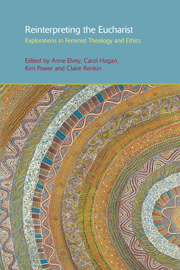Book contents
- Frontmatter
- Contents
- List of Illustrations
- Foreword
- Acknowledgements
- Contributors
- 1 Introduction
- 2 Eucharistic Metamorphosis: Changing Symbol, Changing Lives
- 3 The Sunday Eucharist: Embodying Christ in a Prophetic Act
- 4 How Australian Aboriginal Christian Womanist Tiddas (Sisters) Theologians Celebrate the Eucharist
- 5 Women, Eucharist, and Good News to All Creation in Mark
- 6 Rediscovering Forgotten Features: Scripture, Tradition and Whose Feet May Be Washed on Holy Thursday Night
- 7 Mystery Appropriated: Disembodied Eucharist and Meta-theology
- 8 Real Presence: Seeing, Touching, Tasting: Visualizing the Eucharist in Late Medieval Art
- 9 Embodying the Eucharist
- 10 Living One for the Other: Eucharistic Hospitality as Ecological Hospitality
- Subject Index
- Name Index
1 - Introduction
- Frontmatter
- Contents
- List of Illustrations
- Foreword
- Acknowledgements
- Contributors
- 1 Introduction
- 2 Eucharistic Metamorphosis: Changing Symbol, Changing Lives
- 3 The Sunday Eucharist: Embodying Christ in a Prophetic Act
- 4 How Australian Aboriginal Christian Womanist Tiddas (Sisters) Theologians Celebrate the Eucharist
- 5 Women, Eucharist, and Good News to All Creation in Mark
- 6 Rediscovering Forgotten Features: Scripture, Tradition and Whose Feet May Be Washed on Holy Thursday Night
- 7 Mystery Appropriated: Disembodied Eucharist and Meta-theology
- 8 Real Presence: Seeing, Touching, Tasting: Visualizing the Eucharist in Late Medieval Art
- 9 Embodying the Eucharist
- 10 Living One for the Other: Eucharistic Hospitality as Ecological Hospitality
- Subject Index
- Name Index
Summary
It has taken many grains to produce this one basket of bread, each loaf unique to its author, but all equally nourishing and transforming. The first seeds were sown when Carol Hogan, a woman who has dedicated herself to becoming a eucharistic woman, chose a seminar on Eucharist to celebrate her Golden Jubilee with the Sisters of the Blessed Sacrament. Each of the editors presented papers that were the first provings of the loaves they offer here today, and the prayer that introduces Anne Elvey's essay was especially written for the Eucharist celebrated that day. Such was the response to the seminar that the idea of a book took root. Although a critique of established positions is integral to these contributions, the editors envisage this work as participating in what Mary Grey has termed a ‘reconstructive moment’ when ‘key doctrines are re-envisioned, factoring in life experience, dreams and critical reflections of women from diverse contexts’.
These essays offer a new symbolic or world view, drawn from women's experience and research, as they speak their truth. The intention is not to replace men's discourse, or even to displace it, but to enter into conversation with it. Generations of research have exposed the gendered nature of symbolic worlds—how our experience as gendered beings in androcentric and often patriarchal cultures creates different symbolic worlds for each sex: one public, normative and respected, the other private, alien, ‘Other’, and often trivialized. As Caroline Walker Bynum established, symbols may function for men and for women in radically different ways, though, as women were educated to see the world through masculine experience, women are better at speaking both languages of gender.
- Type
- Chapter
- Information
- Reinterpreting the EucharistExplorations in Feminist Theology and Ethics, pp. 1 - 9Publisher: Acumen PublishingPrint publication year: 2012

